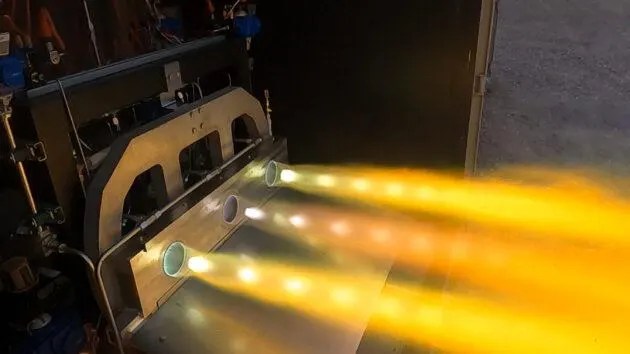
Stoke Space stakes its claim in the launch industry’s rush to fully reusable rockets (Image Credit: SNN)
In just six months, Kent, Wash.-based Stoke Space Technologies has turned a blank stretch of ground in Moses Lake, Wash., into a bridgehead for building a fully reusable rocket optimized for satellite launches.
“It was barren desert as recently as April,” co-founder and CEO Andy Lapsa told GeekWire, “and we were able to get all of the facilities up and running in order to run long-duration, liquid-hydrogen, liquid-oxygen rocket engine testing out there.”
The 2.3-acre test facility at Moses Lake’s airport already has seen action: Last month, Stoke Space completed a manufacturing demonstration of a full-scale second stage for its yet-to-be-named rocket. The two-year-old startup has also done full-power test firings of components for its second-stage rocket engine, a triplet of thrust chambers that Lapsa calls the “three-pack.”
“We did them on time and under budget actually, which I’m very proud of,” said Lapsa, a veteran of Jeff Bezos’ Blue Origin space venture. “You don’t hear that too much in our industry.”
Like Bezos and his billionaire rival at SpaceX, Elon Musk, Lapsa and his teammates at Stoke Space are chasing the dream of full rocket reusability. Their aim is to bring down the cost of access to orbit and open up a new wave of space applications.
SpaceX’s Falcon 9 and Falcon Heavy rockets have shown the way with first-stage reusability, but even those launch systems throw away the second stage after one use. Reducing that cost is what SpaceX’s Starship development program is all about. Blue Origin is also pursuing second-stage reusability as it works on its orbital-class New Glenn rocket, with a program code-named Project Jarvis.
Lapsa lauds the commitment that those bigger launch companies have made to full reusability, but says his venture is taking a different approach.
“The first place to start is with the second stage,” he said. “The full system is designed to be 100% reusable at a high cadence, and I think the industry is still searching for that solution.”
When Lapsa talks about high cadence, he means being able to launch the same low-cost rocket on a daily basis without having to go through detailed inspections or component replacements — just fuel it up and lift off, following the model set for commercial aviation.
It’s still early days: Lapsa said that so far, the full-power thrust chamber firings have lasted no more than 10 seconds, and he’s reluctant to provide details about the levels of thrust.
“We’re starting with these thrust chambers,” he said. “We have turbo machinery which is going to be testing pretty soon. We’ll step into full engine testing, which will be amazing. We have some more facility building to do in order to be able to do that. And in parallel, we’ll be working on the full stage.”
Lapsa said Stoke Space’s workforce has grown to 18 employees, with more hires ahead. The team, which includes folks with experience at Blue Origin, SpaceX and Spaceflight Inc. under their belts, will have to hustle to stick to the timeline.
“We’re going to fly this thing by the end of next year,” Lapsa said.
Lapsa isn’t ready to say where the flight tests will take place, but he did drop some hints about the flight profile. Like Starship, they’ll be vertical-takeoff, vertical-landing trials. Unlike Starship, the descents won’t require belly flops or other exotic maneuvers. “Our entire profile will have the acceleration vector along the center-line axis,” Lapsa said.
One of the key technologies has to do with the second-stage heat shield: Rather than making use of ceramic tiles, Stoke Space plans to construct a ductile metallic heat shield from everyday materials.
Eventually, Stoke Space aims to field a fully reusable rocket with a quick turnaround that’s well-suited for satellite launches.
“The Starship-class vehicle is good for certain things, like colonizing Mars,” Lapsa said. “But I think when you look exclusively at the satellite market, there are very few customers who want to fly that many things all at once. And there are very few customers who want to share a ride with that. We see that already as a pretty big headwind in the industry.”
Will Stoke Space have the wherewithal to reach its goal of 100% rocket reusability? SpaceX is thought to be spending billions of dollars on Starship, while Jeff Bezos has said he cashes in a billion dollars’ worth of Amazon stock every year to fund Blue Origin. In contrast, Stoke Space has brought in $9.1 million in seed funding so far, plus development grants from NASA, the National Science Foundation and the U.S. Space Force.
Lapsa said Stoke Space is looking at different ways to bring in further capital, but for now, getting to the next stage of second-stage development is the first priority.
“Our approach to grants is, if there are opportunities to help attack things we’re already doing, we’ll go after it,” he said. “But otherwise, we’re heads down — and trying to move just as fast as possible.”
– Advertisement –









